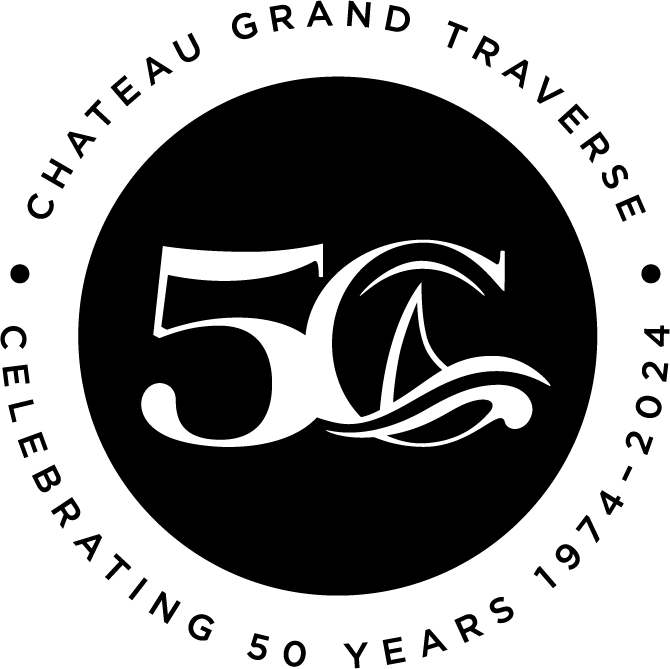BEHIND THE SCENES: A WINEMAKER’S LIFE
Becoming a winemaker requires extensive knowledge and a passion for wine. Find out what it’s like to be a CGT winemaker, how much chemistry is actually involved, and what an average day looks like.
What Does a Winemaker Do?
Winemakers, also known as vintners and enologists, are responsible for overseeing the entire wine production process. This includes grape-growing and harvesting, the art and chemistry of winemaking, and can even cover sanitization and data logging that helps move the winemaking process forward.
At Chateau Grand Traverse, you can find Lab and Enologist Assistant Kurtis Berry working on 10 to 15 tasks simultaneously. He’s constantly running between the vineyard, cellar, lab, and barrel room, working on everything from next year’s vintage to last year’s vintage.
How Much Chemistry Is Involved in Winemaking?
There’s quite a bit! Assessing the wine’s pH level to measure ripeness in relation to acidity, for example while evaluating the wine’s aroma and flavor. This means that if a wine is too bitter or too sweet, the team needs to know how many grams per liter needs to be corrected to get to the correct final product.
Winemakers don’t necessarily spend their days in lab coats balancing chemistry equations, but they do need to understand reactions, take measurements, and make calculations to fashion the juice into the most perfect wine possible.
A CGT Winemaker’s Day
For a CGT winemaker, each day is different. Take a look into a few seasons our winemakers experience and what they do during each:
Summer for Winemakers
In the summer, you can find our team finalizing blends from last year’s harvest by testing the contents of more than 100 tanks with a wine thief. Depending on the wine type, samples are taken to see if they’re ready to be bottled or added into a blend. This is where that applied science comes in as well, as the winemakers create a mental (and digital) log of each tank and how they will change or manipulate the blend.
Fall for Winemakers: Harvest
Harvest is the busiest season for winemakers. You will find CGT vintners in the vineyard to take fruit samples, monitor growth, and provide potential harvest estimates to know the incoming fruit amounts. This then leads to a taste evaluation of micro pressing and fruit assessments for pH and sugar levels (brix).
After the fruit has been harvested, usually in October, the team adds natural enzymes to bring out different flavors and then moves to filtering and fermenting. While all of the winemaking process is going on, paperwork and a virtual winery program are also simultaneously operating. Everything that is done in the real world has to be recorded in an electronic journal to make sure processes, notes and ideas are tracked for future harvests.
Winter for Winemakers
Once the harvest season is complete, the CGT team spends time refining the juice and wine. This is also the time when bottling takes place. As soon as the wines are done fermenting, the CGT team bottles them and then gets this year’s wine ready to start the fermentation process.
How Do You Become a Winemaker?
Becoming a winemaker requires extensive wine experience, applied science and chemistry knowledge, and a passion for wine. Going to school to become a winemaker paired with an understanding of worldwide wine culture can help you become a winemaker. As wine continues to become more popular, wine programs and internship opportunities have also been growing.
Bernd Croissant is the head winemaker at Chateau Grand Traverse. His passion for winemaking started as a child, when he would assist his father in their family vineyards in Germany. To become a winemaker, he had formal training and apprenticeships at several wineries while earning a wine studies degree. After intensive wine studies and experiences, Bernd became the winemaker at CGT in 1993.
What Is the Best Part About Being a Winemaker?
According to CGT’s own Kurtis Berry, the best part about being a winemaker is putting in all the effort and hours and seeing the winemaking process through from start to finish. It’s satisfying, he says, to directly see what your time and energy has gone towards, and to get to see the grapes through the whole process and, of course, to get to indulge in the fruits of your labor at the end of the journey.
Visit Us at Chateau Grand Traverse
If you’d like to take a deeper look into the winemaking process for yourself, visit us at Chateau Grand Traverse, take a tour, and get a behind-the-scenes look into our operations.
If you’re ready to taste test our winemaking process for yourself, visit your local wine retailer or check out our online shop to snag your favorites CGT wines today.


